Released in 1971 and directed by Stanley Kubrick, A Clockwork Orange was by far one of the 20th century’s most controversial films.

Poster for A Clockwork Orange
Based on Anthony Burgess’ 1962 novel of the same name (the title being inspired by the old Cockney phrase “as queer as a clockwork orange’), the story is set in a dystopian London of the near future and centres on Alex DeLarge–a sadistic youth with a passion for Beethoven- who leads his gang of ‘droogs’ through the city on nightly sprees of ultra-violent mischief.

Alex De Large stares at the camera in the film’s iconic opening shot…
After committing murder, Alex is finally locked up… but is soon offered a quick way out when he agrees to act as a guinea pig for the Ludovico Technique; a controversial brain-washing programme designed to suppresses the desire for violence (and something which caused actor Malcolm McDowell great pain and discomfort when it came to portraying these disturbing scenes).

Alex undergoing the Ludovico Technique
In Britain, thanks to high levels of upset whipped up in the press, the film version of A Clockwork Orange gained such an intense notoriety that Stanley Kubrick himself withdrew his work from circulation; a self-imposed ban which remained right up until 2000.
So strict was this embargo that, in 1993 when the Scala Cinema in Kings Cross attempted to screen the film, Warner Brothers took the owners to court; an action which led to the cinema going bust thanks to the immense legal costs involved.
Considering A Clockwork Orange was filmed entirely around London and the Home Counties (including areas such as Borehamwood, Kingston-Upon-Thames, Elstree, Radlett, Brunel University, Bricket Wood and Wandsworth prison) it’s rather ironic that British audiences were forbidden from viewing Kubrick’s film for so many years.
Here are some of the film’s most prominent London-based scenes:
The Chelsea Drugstore
Whilst Alex’s nights are spent committing all manner of horrific acts whilst tanked up on drug-laced milk, his days are rather more civil… devoted to indulging his love of classical music; especially that of the “lovely, lovely Ludwig Van” Beethoven.
In one of the film’s scenes, we follow Alex, decked out in his dandiest threads as he peruses his favourite record shop (click below to view):
This scene was filmed in the basement of the Chelsea Drugstore; a modern building fashioned from glass and aluminium which opened on the King’s Road in 1968.
Open 16 hours a day, 7 days a week, the Chelsea Drugstore was an avant-garde, mini shopping mall, its three floors boasting eateries, boutiques, a record shop, bar, newsagent and chemist.
It also boasted its own ‘Flying Squad’… an exclusive team of women clad in purple castsuits who were employed to make unconventional home deliveries on their fleet of motorbikes. Groovy!
The Chelsea Drugstore was also name checked in The Rolling Stone’s 1968 hit, You Can’t Always Get What You Want.” (Speaking of The Stones, Mick Jagger was once earmarked to play Alex DeLarge in an earlier proposed adaptation of Burgess’ novel which never came to fruition…)
Although the Chelsea Drugstore ceased trading in 1971, the shops in the basement (as featured in A Clockwork Orange) remained in place until the late 1980s whilst the rest of the building became a wine bar.
Today, the building is occupied by the Chelsea branch of McDonalds.
*
Thamesmead
Despite the inclusion of the psychedelic Chelsea Drugstore, A Clockwork Orange is mostly set against a cold, dystopian backdrop; a precedent set in Burgess’ original novel as the following excerpt, in which Alex and his gang are evading the police, atmospherically illustrates:
“Just round the next turning was an alley, dark and empty at both ends, and we rested there, panting fast then slower, then breathing like normal. It was like resting between the feet of two terrific and very enormous mountains, these being flatblocks, and in the windows of all the flats you could viddy like blue dancing light. This would be the telly. Tonight was what they called a worldcast, meaning that the same programme was being viddied by everyone in the world that wanted to… and it was all being bounced off the special telly satellites in outer space.”
In order to realise Burgess’ bleak, futuristic vision Stanley Kubrick turned to the modern, Brutalist architecture which was sprouting across London during the era in which the book and film were created; architecture which, as early as 1962, Anthony Burgess was already predicting would provide fertile ground for many unforeseen social ills.
In Burgess’ novel, Alex lives in “Municipal Flatblock 18a”, a block daubed in obscene graffiti and plagued by vandalism.
To represent this domestic seediness, Kubrick took his film crew to the newly built Thamesmead Estate; a vast, sprawling development near Woolwich in South East London.
Built on a former military site, the Thamesmead Estate, which was optimistically promoted as being the “town of the twenty-first century”, was built piecemeal between the 1960s and 1980s.
One of the film’s most famous sequences takes place on Thamesmead’s Binsey Walk.
Walking alongside the man-made Southmere Lake Alex, whose leadership has just been challenged, decides to show his droogs whose really in charge (click below to view):
In recent years, the Thamesmead Estate has been used as a set for the E4 comedy, ‘Misfits‘.
*
York Road Roundabout, Wandsworth
One of the most notorious scenes in Kubrick’s adaptation takes place at the very beginning of the film and involves a vicious assault on a hapless down and out as he lies drunkenly in a grimy, pedestrian subway.
The scene was filmed in the warren of walkways beneath York Road roundabout, which sits at the southern foot of Wandsworth Bridge.
Typical of the architecture of the time, York Road roundabout was laid out in 1969 and was pretty much brand new when Stanley Kubrick set up his cameras.

Stanley Kubrick with Malcolm McDowell on set below York Road roundabout, 1971 (image: Stanley Kubrick Archive).
Today, the labyrinth beneath the roundabout is just as bleak and unwelcoming as it was some 40 years ago…
More recently, a large atom-esque sculpture of sorts has been plonked down on the roundabout, becoming something of a local landmark.
Apparently inspired by the 1950’s Atomium sculpture in Brussels, but kitted out with a bulky and intrusive advertising gantry, the tangle of metal doesn’t really do much to beautify the 1960s concrete…
*
Albert Bridge
As for the unfortunate tramp who was attacked by Alex and his droogs below Wandsworth’s grimy roundabout… don’t worry, he gets his own back…
After recognising the recently released (and now, thanks to his treatment, defenceless) Alex DeLarge glumly contemplating a view of the Thames, the tramp leads his own rabble in a revenge attack on the former and now defenceless yob, right beneath Albert Bridge; one of London’s most beautiful river crossings (click below to view):
*
Want more on Stanley Kubrick’s London? Then check out this post: A Monolith in St Katherine Docks…
***



















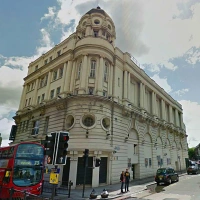

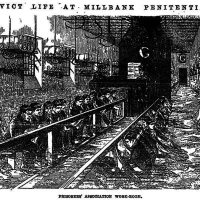
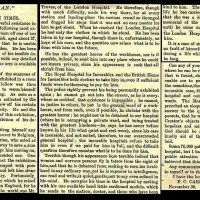


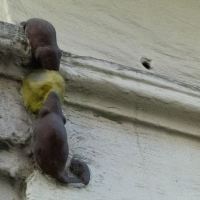
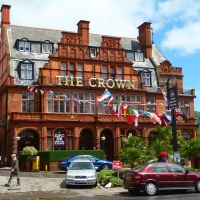

[…] The London locations from the film of A Clockwork Orange. […]
Wow! What a blog! A living history…. I’m in love 🙂
Thank you so much for the kind words, Barbara… very much appreciated 🙂
My next door neighbour in Highgate worked on this film (sound dept) and has great stories on what Kubrik was like to work with. I always look forward to your posts. Between castings and auditions I’m busy doing the knowledge myself pretty much full time now and it’s much more enjoyable if you have a genuine love for this city. Having lived in Clerkenwell, Chiswick, Holborn, Barbican, Holland Park and now Highgtate, not to mention years walking around and working in the city and west end I thought I knew London, after 10 months of the Knowledge you realise how much more there is to discover.
Thanks, Ford. As long as you enjoy exploring London, you’ll certainly pass the Knowledge! And when you start working, you’ll discover even more… there’s no end to the hidden secrets out there! Thanks again… keep at it and stay safe.
Another brilliant piece, I do wish your blog had been around while I was guiding on the sightseeing buses. Much as I’d researched all I could, there are some tiny gems I could have done with knowing back then.
By the way, the Chelsea Drugstore, before it became a MaccyDo’s, in 1988 it opened as a specialist Virgin Megastore that only sold CDs. This was when vinyl and tape was still king. CD was only 5 years old at the time, but the record companies had gone into overdrive to promote it as the medium of choice. Cost of vinyl and cassettes suddenly went up, while CDs came down in price, which ‘helped’ to make CD the main music medium. At the time, there were a handful of CD specialist stores, there was one in Victoria Place above Victoria station, the name of which escapes me right now. The main record chains sold them, but only had small departments for the shiny discs, most of them were classical. Virgin got in on the act in the trendiest part of London and opened their CD only store there. Needless to say, it didn’t last too long, as they got in on the act rather late in the day, when CD had already overtaken vinyl. When CD dominated the high street, there was no longer any need for a specialist sub-chain.
Many thanks for the kind words, Darren.
I never knew the old Chelsea Drugstore became a CD only shop, that’s very interesting indeed. Many thanks for the info 🙂
Were obviously of the same generation for this to be of relevance-quite ironic that some of these places were to be avoided in future years-I remember the Scala very well-all night James Dean movies for example, and smoking and everythign else in the seats…it is a sadly missed icon. Fonbd memories.
Very true, many things seem a lot more sterile nowadays.
During the student occupation of the London School of Economics in1968 I pasted a revolutionary poster on the Chelsea Drugstore. Ah, happy days.
Thanks for sharing that, John. Great memory 🙂
I love London, I love literature and I have great memories of living in the capital. Thank you so much for sharing this with us! Next time I visit, I want to see that ‘atom’ sculpture!
Thank you, John for your kind words.
Hey,
Great post about a great film. I’d love to visit those places.
Couple of notes though; Clockwork Orange is set in Salford, not London. He just liked to film near home and did the same with many (all?) of his later films, including Full Metal Jacket (set in US and Vietnam) and Eyes Wide Shut (set in US).
Also, the film was pulled by Kubrick personally yes, but specifically because threats were made to the Kubrick household. (According to Christiane Kubrick).
Cheers cb
Hi CJ,
Thanks for the kind comments.
I must admit I never knew there was a link between A Clockwork Orange and Salford although I know Anthony Burgess was from nearby Manchester. From what I can remember of the book, the actual town/city is never specified (although my memory may be failing me!)
I assumed Kubrick’s version is set in and around London due to certain landmarks appearing in the background- namely Battersea Power station and Albert Bridge.
Also, when the ‘cat lady’ calls the law, she asks for “Radlett police staion” which is in Hertfordshire just outside of London and a fast drive for droogs in a stolen car… Kubrick himself also lived in Hertfordshire as I’m sure you know.
Thanks again 🙂
What about the Pub that was featured in the film? Also that Chelsea Drugstore looked amazing back in the day! Is it safe to have a look at Thamesmead cos i’d love to visit the area near the lake and relive the scene there! He He
The pub no longer exists… it was called the ‘Old Leather Bottle’ and was based in Stanmore. It’s now a block of flats. Thamesmead should be no problem, best seen during the daytime though.
[…] before looping back home. The Chelsea Drugstore really existed as a pharmacy on King’s Road (and even appears in A Clockwork Orange) back when the Stones were getting what they need. I followed the edge of Green Park to Buckingham […]
[…] Burgess, A. (2013) A clockwork orange. London, United Kingdom: Penguin Classics. ‘A clockwork orange, flat block marina scene’. (2009) Created by Howard, J. 2 June 2009. At: https://www.youtube.com/watch?time_continue=1&v=HtRGeyznv7k View from the Mirror. (2012) Droogs about town. At: https://blackcablondon.net/2012/11/21/droogs-about-town-london-locations-featured-in-a-clockwork-ora… […]
Do you know the exact location of the photo captioned “Screenshot of the Thamesmead as depicted in A Clockwork Orange…”?
I don’t I’m afraid Phil, sorry.
The pub The old Leather Bottle was in Edgware NOT Stanmore. I grew up in Edgware and frequented that pub quite a lot. To be more precise the pub was in Stonegrove, Edgware where I lived as a baby and young child.
Thanks for clearing that up Angela.
https://www.google.com/maps/place/Canterbury+House,+Borehamwood+WD6+1NT/@51.6610413,-0.2759195,3a,75y,123.48h,93.77t/data=!3m6!1e1!3m4!1sgbhvfLsw4SRo0Ktsy6TBHw!2e0!7i16384!8i8192!4m5!3m4!1s0x487616732252cabd:0x7cb12e125f39f33f!8m2!3d51.6609184!4d-0.2754426
there is plaque by the entrance of Canterbury house WD6 commemorating that it was used in filming off a Clockwork Orange
That’s a great piece of info! Many thanks for sharing.